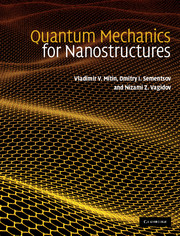Book contents
- Frontmatter
- Contents
- Preface
- List of notation
- 1 The nanoworld and quantum physics
- 2 Wave–particle duality and its manifestation in radiation and particle behavior
- 3 Layered nanostructures as the simplest systems to study electron behavior in a one-dimensional potential
- 4 Additional examples of quantized motion
- 5 Approximate methods of finding quantum states
- 6 Quantum states in atoms and molecules
- 7 Quantization in nanostructures
- 8 Nanostructures and their applications
- Appendix A Classical dynamics of particles and waves
- Appendix B Electromagnetic fields and waves
- Appendix C Crystals as atomic lattices
- Appendix D Tables of units
- Index
5 - Approximate methods of finding quantum states
Published online by Cambridge University Press: 05 June 2012
- Frontmatter
- Contents
- Preface
- List of notation
- 1 The nanoworld and quantum physics
- 2 Wave–particle duality and its manifestation in radiation and particle behavior
- 3 Layered nanostructures as the simplest systems to study electron behavior in a one-dimensional potential
- 4 Additional examples of quantized motion
- 5 Approximate methods of finding quantum states
- 6 Quantum states in atoms and molecules
- 7 Quantization in nanostructures
- 8 Nanostructures and their applications
- Appendix A Classical dynamics of particles and waves
- Appendix B Electromagnetic fields and waves
- Appendix C Crystals as atomic lattices
- Appendix D Tables of units
- Index
Summary
The solution of most problems associated with electron quantum states in physical systems and structures (atoms, molecules, quantum nanostructure objects, and crystals) is hard to find because of the mathematical difficulties of getting exact solutions of the Schrödinger equation. Therefore, approximate methods of solving such problems are of special interest. We will consider some of these methods, such as the adiabatic approximation now and later the effective-mass method, using real physical systems as examples. In this chapter we will consider several widely used approximation methods for finding the wavefunctions and energies of quantum states as well as the probabilities of transitions between quantum states. First of all, we will consider stationary and non-stationary perturbation theories. What is common to these two theories is that it is assumed that the perturbation is weak and that it changes negligibly the state of the unperturbed system. Stationary perturbation theory is used for the approximate description of a system's behavior if the Hamiltonian of the quantum system being considered does not directly depend on time. In the opposite case, non-stationary theory is used. Then, we will briefly consider the quasiclassical approximation, which is used for the problems of quantum mechanics which are close to analogous problems of classical mechanics.
Stationary perturbation theory for a system with non-degenerate states
This theory is used for the approximate calculation of the energy levels and the wavefunctions of stationary states of systems that are subjected to the influence of small perturbations.
- Type
- Chapter
- Information
- Quantum Mechanics for Nanostructures , pp. 136 - 154Publisher: Cambridge University PressPrint publication year: 2010



